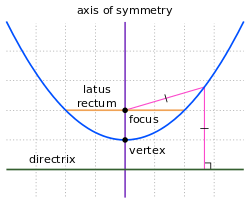放物線
Japanese
[edit]| Kanji in this term | ||
|---|---|---|
| 放 | 物 | 線 |
| ほう Grade: 3 |
ぶつ Grade: 3 |
せん Grade: 2 |
| kan'on | ||
| Alternative spelling |
|---|
| 抛物線 |

Etymology
[edit]Appears in Japanese in 1872 in the 代微積拾級訳解 (Dai Biseki Jikkyū Yakkai, literally “Translation and Explication of Algebraic and Differential Calculus”), a Japanese translation by 福田理軒 (Fukuda Riken) and 福田半 (Fukuda Han) of the 1851 book Elements of Analytical Geometry and of the Differential and Integral Calculus by Elias Loomis. According to the foreword,[1] the translators referenced an earlier Chinese translation from 1859, so the term likely derives originally from Chinese 拋物線 / 抛物线 (pāowùxiàn) (see that entry for further details).
According to other Japanese sources,[2][3][4][5] analyzed as a compound of 抛物 (hōbutsu, literally “throwing thing”, perhaps in reference to the etymology of parabola) + 線 (sen, “line”). See also related term 放物面 (hōbutsumen, “paraboloid”).
Note the shift from earlier spelling 抛物線, now considered an archaic alternative, to 放物線 in modern usage. 放 (hō, “to release, to set free”) is a daiyōji replacing 抛 (hō, “to throw, to hurl”).
Pronunciation
[edit]- (Tokyo) ほーぶつせん [hòóbúts
úséń] (Heiban – [0])[3][6][5] - (Tokyo) ほーぶつせん [hòóbúꜜts
ùsèǹ] (Nakadaka – [3])[6] - IPA(key): [ho̞ːbɯ̟t͡sɨ̥sẽ̞ɴ]
Noun
[edit]放物線 • (hōbutsusen) ←はうぶつせん (faubutusen)?
See also
[edit]- 放物面 (hōbutsumen, “paraboloid”)
- 円錐曲線 (ensui kyokusen, “conic section”)
- 双曲線 (sōkyokusen, “hyperbola”)
- 楕円 (daen, “ellipse”)
References
[edit]- ^ 1872, 代微積拾級訳解 (Dai Biseki Jikkyū Yakkai), 福田理軒 (Fukuda Riken) and 福田半 (Fukuda Han) translators. Image at Waseda University of the foreword from (in Japanese). The text is an 1872 Japanese translation of the 1851 book Elements of Analytical Geometry and of the Differential and Integral Calculus by Elias Loomis.
- ^ Shōgaku Tosho (1988) 国語大辞典(新装版) [Unabridged Dictionary of Japanese (Revised Edition)] (in Japanese), Tōkyō: Shogakukan, →ISBN
- ↑ 3.0 3.1 Matsumura, Akira, editor (2006), 大辞林 [Daijirin] (in Japanese), Third edition, Tokyo: Sanseidō, →ISBN
- ^ Matsumura, Akira (1995) 大辞泉 [Daijisen] (in Japanese), First edition, Tokyo: Shogakukan, →ISBN
- ↑ 5.0 5.1 Kindaichi, Kyōsuke et al., editors (1997), 新明解国語辞典 [Shin Meikai Kokugo Jiten] (in Japanese), Fifth edition, Tokyo: Sanseidō, →ISBN
- ↑ 6.0 6.1 6.2 NHK Broadcasting Culture Research Institute, editor (1998), NHK日本語発音アクセント辞典 [NHK Japanese Pronunciation Accent Dictionary] (in Japanese), Tokyo: NHK Publishing, Inc., →ISBN
- Japanese terms spelled with 放 read as ほう
- Japanese terms spelled with 物 read as ぶつ
- Japanese terms spelled with 線 read as せん
- Japanese terms read with kan'on
- Japanese terms borrowed from Chinese
- Japanese terms derived from Chinese
- Japanese compound terms
- Japanese terms with 抛 replaced by daiyōji 放
- Japanese terms with IPA pronunciation
- Japanese lemmas
- Japanese nouns
- Japanese terms spelled with third grade kanji
- Japanese terms spelled with second grade kanji
- Japanese terms with 3 kanji
- ja:Geometry
- Japanese terms suffixed with 線

